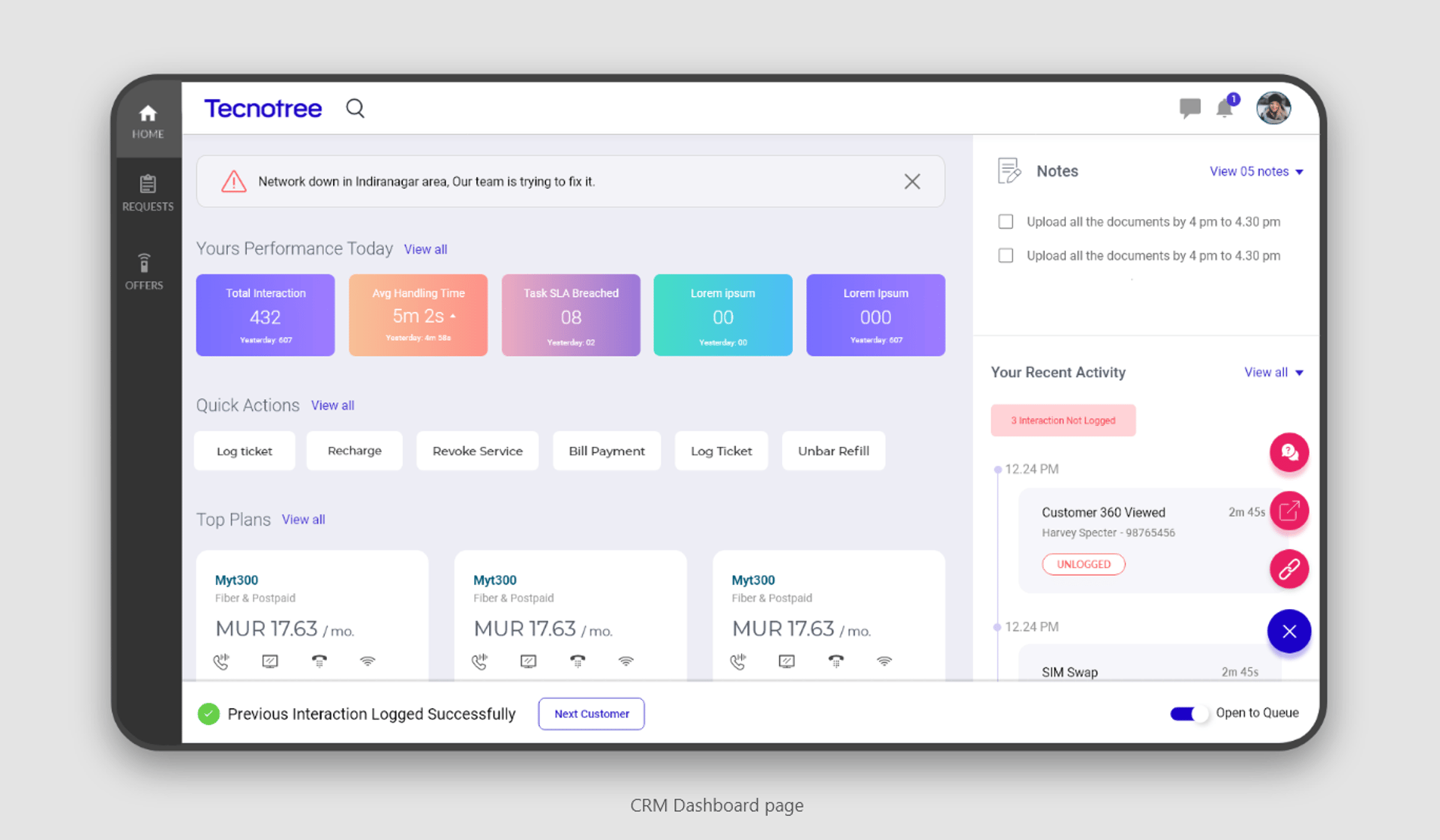
CLM System Redesign
Project Overview
Project Name: Tecnotree Core CLM System Redesign for MTN Irancell
Duration: 10 months - 2020
Role: Senior UX Designer - Tecnotree Onshore Division
Team: A design manager & 3 UI designers
Company: Tecnotree
Client: MTNl (major telecommunications operator)
As the first UX designer hired for Tecnotree's onshore operations, I inherited a critical challenge: The offshore design team had created foundational CRM designs for multiple telecommunications operators, but these generic solutions needed significant adaptation to meet MTN Irancell's specific operational needs, cultural context, and business objectives.
My Story!
When I joined the team, I was the first UX designer of Tecnotree’s onshore branch. Offshore design team was working on designing the new core CRM system for a number of OpCos and my responsibility was to evaluate and redesign those core designs based on MTNI company requirements. Tecnotree is a global provider of IT solutions, and it provides digital products and services including DCLM, DCM, DOM and DCBS for IT companies including MTN Irancell. As it was the rst IT company I was working in, first, I needed to thoroughly understand the products and then identify the business goals. After that I started planning to conduct the user research, drawing customer journeys, desning new features, prioritizing them and lastly, user testing the updated designs.
Through a number of workshops that we had with the business, I found out one of the main goals of business, apart from adapting new technologies in their system and making the products more user-friendly, is to reduce the response time of call center agents. Irancell is a growing company and every day new users are getting to start using their services, and naturally, call centers are getting more and more complaints and general queries from users. So, by achieving that goal, business will be relieved from the costs of hiring new agents.
MTN Irancell's Reality:
Rapid Customer Growth: Daily acquisition of new telecommunications subscribers
Increasing Support Volume: Exponential growth in customer complaints and general queries
Operational Cost Pressure: Rising costs of hiring and training new call center agents
Competitive Pressure: Need for superior customer service to maintain market position
Business Challenges
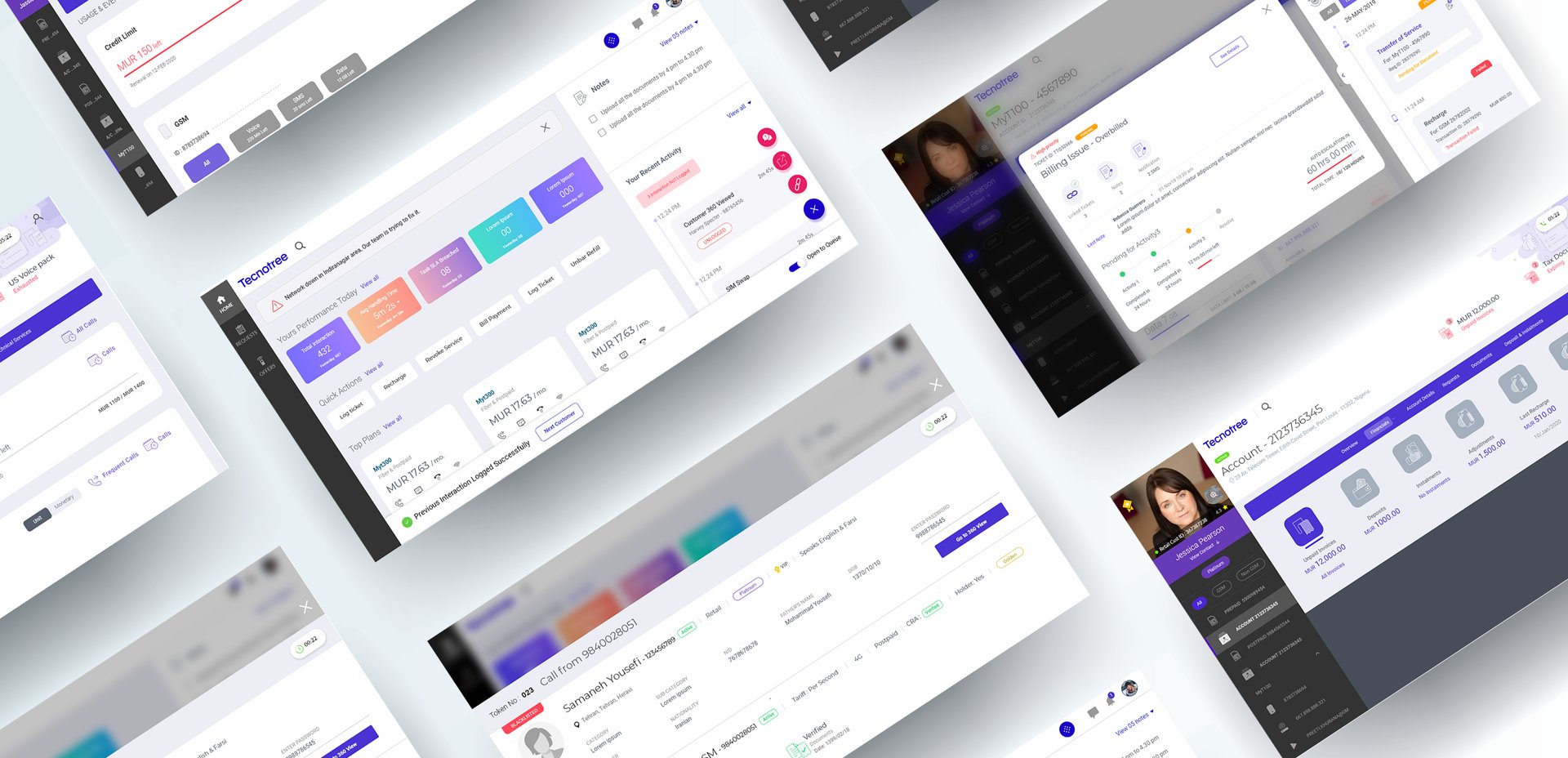
How might we transform generic offshore CRM designs into a user-centered system that reduces MTN Irancell's call center response times while supporting rapid customer growth and operational efficiency?
Problem to solve
To build a deep understanding of user needs and operational challenges, I conducted a series of workshops and research activities combining qualitative and quantitative methods. This included structured questionnaires, prioritization exercises, direct field observation, and stakeholder interviews; engaging with call center staff across roles to uncover pain points, assess feature usage, and identify opportunities for improvement.
Workshops
Structured Questionnaires: Comprehensive survey designed for call center supervisors and managers around current system challenges and suggestions.
Prioritization Exercises: Analyzing the survey answers and ranking business needs and user requirements
Field Study & Direct Observation
Call Center Immersion: Spent 4 hours directly observing agent-system interactions in live environment.
Journey Analysis: Step-by-step walkthrough of typical customer service scenarios
Observational Follow-Up: Targeted questions based on field study observations
Pain Point Identification: Real-time observation of workflow interruptions and inefficiencies
Feature Usage Assessment: Identified unused functionalities and barriers to adoption
Stakeholder Interviews
Agent Interviews: One-on-one sessions with 6 call center agents to understand daily pain points
Cross-Role Perspectives: Gathered insights from front office, back office, help desk, and management roles
Discovery Phase: Understanding the Ecosystem
As my first IT industry role, comprehensive discovery was essential to understand:
Product Portfolio: DCLM, DCM, DOM, and DCBS system relationships and dependencies
Telecommunications Operations: Customer lifecycle management in telecom industry
Regulatory Environment: Iranian telecommunications compliance requirements
Organizational Structure: MTN Irancell's operational hierarchy and decision-making processes
Research Methodology
Business & User Insights
Key User insights (from surveys, observation, and interviews):
Complex Journey Navigation: Multiple convoluted workflows creating confusion and delays
High Click-Count Operations: Excessive interactions required for routine customer service tasks
Feature Bloat: Numerous unused functionalities cluttering the interface and slowing workflows
Poor Usability: Non-intuitive design patterns hindering agent productivity
Dual Platform Challenge: Agents forced to work across two separate systems for call handling, making complaint resolution inefficient
Information Fragmentation: Critical customer data scattered across multiple system sections
System Context Switching: Agents spending 30% of call time navigating between interfaces
Strategic Business Goals Identified (from workshop):
Primary Objective: Reduce call center agent response time to manage growing support volume
Technology Modernization: Adapt new technologies while improving product user-friendliness
Cost Optimization: Avoid proportional hiring increases by improving agent efficiency
Scalability: Build sustainable customer service operations supporting continued business growth

Solutions
To start, I needed to define personas to determine how many versions of system pages I needed to design. The CLM system is used by various roles, so I studied each role’s tasks, responsibilities, and permissions to accurately create these personas. The key roles include Front Office Agents (call center), Back Office Agents, Help Desk, Supervisors, and Managers. Among these, Call Center and Back Office Agents are the primary personas, as they spend most of their day actively using the system to respond to customer inquiries, unlike Managers and Supervisors, who interact less frequently. Since Supervisors and Managers share very similar daily tasks and permissions, I combined them into a single user group. My initial design efforts therefore focused on the Call Center and Back Office Agents.
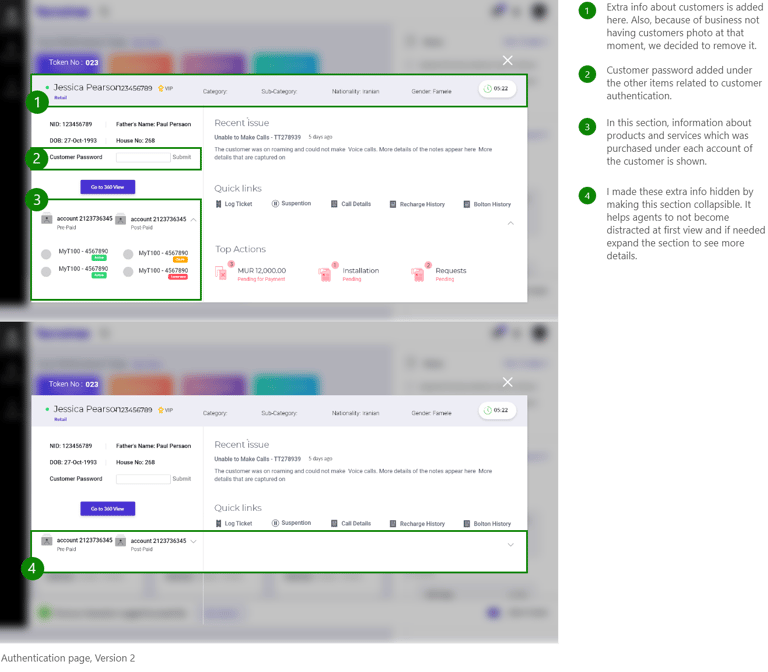

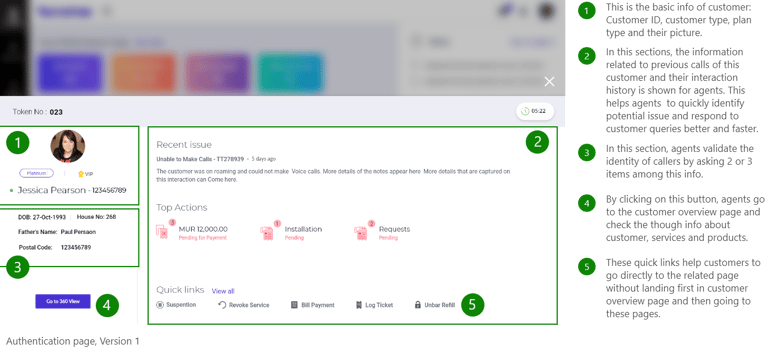



Persona-based Dashboard - Role-specific interface optimization
Customer Authentication - Streamlined identity verification process
Customer 360 Landing Page - Comprehensive customer overview
Flexible Search - Advanced customer and account discovery
Trouble Ticket Management - Efficient issue tracking and resolution
Recent Transactions - Quick access to customer activity history
VAS Details - Value-added services information and management
Call Details - Comprehensive call history and context
View Bill - Customer billing information access
Unified Wallet - Integrated financial account overview
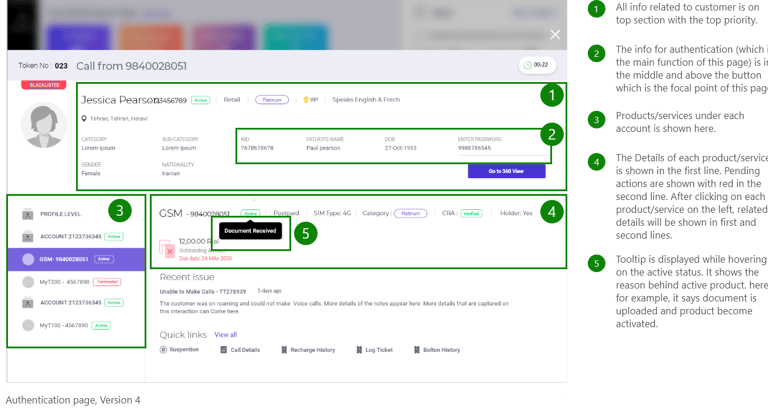

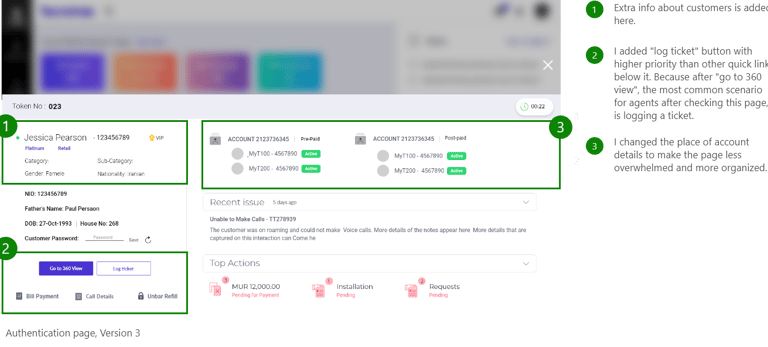

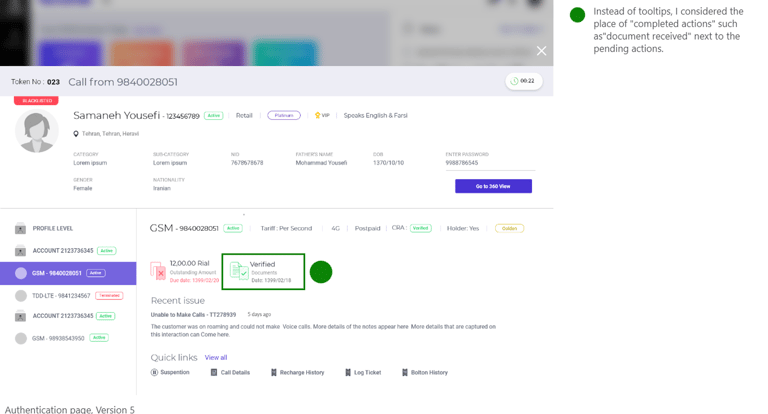

Agile Development & Story Prioritization
As part of our agile process, I collaborated with the PO team and business stakeholders to define and prioritize the top 10 critical pages and workflows for the platform including:
We identified 40 key tasks across 10 primary use cases, then partnered with the PO team; including Product Owners, Product Managers, and Business Analysts, to collaboratively prioritize them. The “in scope” requirements were strategically integrated into the product development roadmap, with story weighting applied to ensure the most critical user needs were addressed first.
Metrics Definition & Success Measurement
I de ned usability metrics to have a quantitative data before and after the launch of new system. I considered these metrics for analyzing the efficiency and effectiveness of CLM system: 1. Task completion time 2. Number of errors 3. Task success rate After studying call center agents’ journey scenario, and observing how they speak with the customers, answer their calls and creates tickets in the system, I decided to only focus on task completion time metric as all of the agents are master in their job and they have known and used the current system for years. This means that metric number 2 and 3 are not applicable here. The de nition of tasks here are answering the call, solving customers problem, and logging a ticket. Task completion time in current CLM system for general queries and complaints: Average 2 minutes = 120 Second.
The first use case in the UX backlog
For designing the authentication page, rstly, I needed to thoroughly understand this step and the reason behind it. As this step is the first page agents encounter with after connecting to the customer, it is important to be quick, provide enough information for authenticating of customer, and also include quick links and extra info which relive agents from checking other tabs of the system to nd that information. Back office agents do not need to interact with this page as they do not communicate with the callers directly.
After authenticating customers, agents go to 360 landing page (customer overview page) and depending on the type of customer request or complaint, they review the info in this page or info inside other tabs above. After answering the call, they log a ticket and connect to the next caller. For making this journey quicker, we requested the business to send us the top 5 issues and queries asked by customers during the last 6 months. By doing that, we wanted to display some of those important info inside the authentication page, so that the agent is no longer needed to go to 360 page and check the info on that page. I also wanted to know the most frequently used tabs so that I could place a set of quick links in the authentication page that navigates agents directly to those pages instead of first going to 360 and then click on the above related menu. For example, for general queries which does not need checking the 360 page, agents can log ticket in the authentication page while currently for all queries they first need to go to the 360 page and then log a ticket.
Iterative designs - Usability testings
For each journey, I allocated one to two weeks for focused design work, structuring the process to include iterative critique sessions with BAs, PMs, the PO, and both design and development teams. This collaborative cadence enabled rapid, early-stage feedback, reducing rework and accelerating alignment across disciplines.
In the initial version, I prioritized essential elements for customer validation and introduced a streamlined “Recent Issues,” “Top Actions,” and “Quick Links” module. This design empowered agents to anticipate a customer’s likely reason for calling and address inquiries directly—without navigating to the customer dashboard—significantly improving response speed and operational efficiency. I designed 3 versions:
After discussing all the 3 variations with product team I came up with version 4.
On this version, I tried to focus more on the layout and design to make it less overwhelmed. I consulted with design team and we decided to have 3 sections instead of 2 which shows the data in a more organized way.
After the PO team approved the design, I moved into user testing by creating an interactive Adobe XD prototype. The flow covered the complete experience, from the agent’s dashboard through to the Customer 360 page or other quick link destinations, so participants could interact with it as they would in a live environment.
I conducted one-on-one remote usability sessions with five agents, asking them to complete defined tasks while I observed their navigation patterns, decision points, and potential friction areas. Overall, the interactions felt smooth and intuitive, with most participants completing tasks without additional guidance.
Some user feedback:
“Hover effect” could become distracting as the cursor moved across the screen.
Slightly increasing the prominence of the “Top Actions” section and making “Recent Issues” to make it more scannable at a glance.
Adding clearer visual separation between customer validation details and quick links to improve readability.
Business & User Insights
After sharing the findings with the design and product teams and outlining a plan to implement the feedback, I began working on the next user journey.

We successfully reduced the “time on task” metric, bringing the average task completion time for general queries and complaints in the CLM system down to 78 seconds, a 35% decrease in call response time.
Results
The PO requested that we surface extensive customer purchase information on the authentication page, a decision that risked overwhelming users and introducing friction. I approached this challenge by structuring the content in a way that maintained clarity and hierarchy while preserving task focus. Recognizing the potential for usability issues, I recommended a dedicated round of targeted user testing to validate the approach before full rollout.
As the first onshore designer on the project, I quickly assumed a bridging role between the internal stakeholders and the offshore design team. The distributed setup, compounded by a significant time zone gap between Iran and India, required rethinking our communication model. I initiated and formalized fixed bi-weekly collaboration sessions, creating predictable touchpoints that significantly improved alignment and reduced feedback loops.
The CLM system’s complexity, with its numerous interconnected user journeys, demanded a deep understanding of both legacy and new workflows. To ensure impactful demo sessions, I strategically prioritized journeys, conducted in-depth analysis of the old CLM system, and prepared evidence-based talking points to demonstrate the enhanced value of new features. Through close collaboration with PMs and BAs, as well as rigorous review of SRS documentation, I positioned myself to address stakeholder concerns with confidence, shifting conversations from “feature parity” to “performance and experience improvement